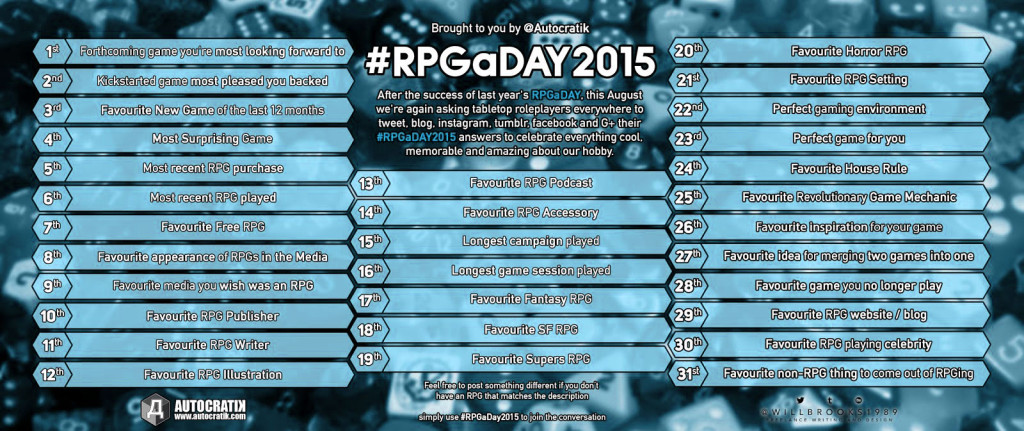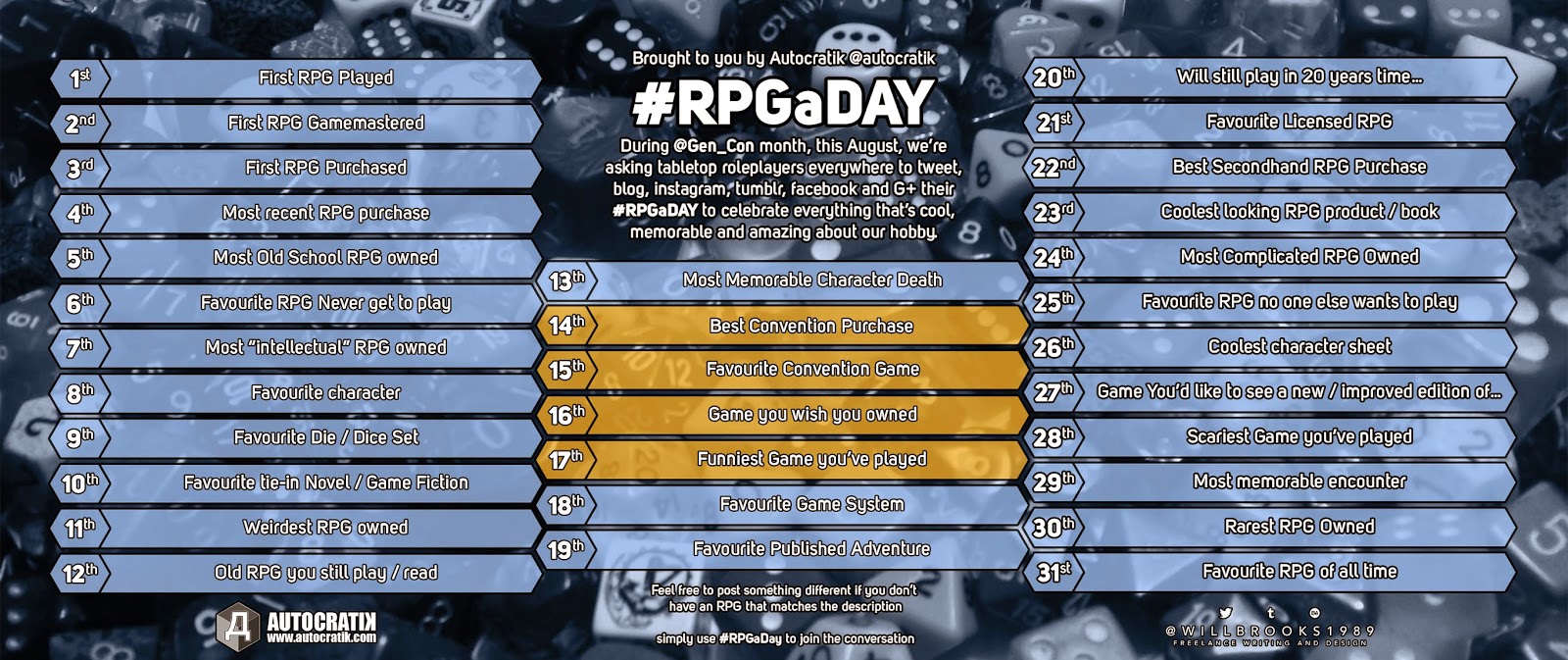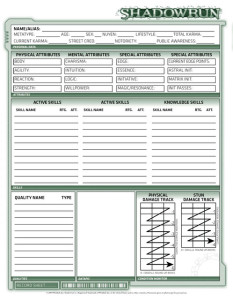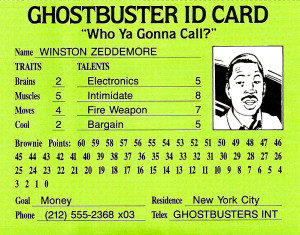Caught up to the current day on #RPGaDAY2015. Whew! So here’s the plan from here on out: in the morning, ((Probably around 11am, EDT.)) a “Last Year” article where I revisit the original writing prompts ((These were originally published on my Google Plus account.)) and seeing if my answers still hold true, one year later. In the afternoon, this year’s daily prompt. Speaking of:
Day 6 of #RPGaDAY2015: What was the most recent RPG you played?

Unfortunately, it’s Shadowrun, 5th Edition.
 Why “unfortunately”? Well, you know how when a new RPG comes out, the first thing people ask are “Can I play Star Wars in it?” The second question they ask is “Can I play Shadowrun in it?” Why do they ask that? It’s because the setting of Shadowrun is amazing. But the game system is such a complicated mess. Just a few hours ago, I posted my answer to last year’s topic, “What’s the most Old School RPG you own?” and the answer was Shadowrun 5th. There’s a few things about it there, but to explain further:
Why “unfortunately”? Well, you know how when a new RPG comes out, the first thing people ask are “Can I play Star Wars in it?” The second question they ask is “Can I play Shadowrun in it?” Why do they ask that? It’s because the setting of Shadowrun is amazing. But the game system is such a complicated mess. Just a few hours ago, I posted my answer to last year’s topic, “What’s the most Old School RPG you own?” and the answer was Shadowrun 5th. There’s a few things about it there, but to explain further:
Shadowrun, 5th Edition, is a continuation of the overly-cumbersome rulesets the game has always had. In order to do anything in the game, there’s a system of rolls in place, and it always seems like there’s two or three steps involved too many. As an example, let’s have a mage cast a spell at a punk-ass bitch. Let’s count.
1. We’re going to cast Lightning Bolt, a simple zap and knock ’em out spell. So step one officially is to select that spell, but we’ll give that to the player for free. “I’m casting Lightning Bolt!” she says. Okay, let’s choose the target. We’ll give that to player for free, too. Our first real step is to see if we can link to the target. That requires line of sight. Can we see him? Yes.
2. Choose the force of the spell. The mage says she’s casting at force 8, which is higher than her Magic ability. Cool.
3. Cast the spell: She rolls Magic + Spellcasting (9 dice total) and gets 3 hits.
4. The opponent resists: He rolls Reaction + Intuition (7 dice) and gets 2 hits.
5. Subtract resisting hits from casting hits, and we have 1 net hit. It’s greater than 0, so the spell hits.
6. Determine the damage value of the spell! Force + net hits = 9. Armor Piercing modifier is -8.
7. Punk ass resists with Body + Armor – AP from step 6! He rolls 3+9-8, four dice, getting 1 hit!
8. Actual damage! Step 6 – Step 7 is 9 – 1, or 8 points of physical damage!
9. Now, it’s an elemental spell (Lightning), so we go to page 170 for what I’m assuming is three more steps.
12. Resist drain! But first, we have to determine it. Drain target is force – 3 for the spell, so our drain value is 5. She got 3 hits in step 3, which is less than her Magic ability, so the drain damage type is Stun.
13. Roll to resist drain. Our mage is rolling Logic + Willpower (10 dice), against 5S damage. Three hits.
14. Determine drain damage. Step 12 minus Step 13 = 5 – 3, or 2 points of stun damage. We’re not sustaining the spell (can’t with the spell type), so we’re good to go. Done.
Holy crap. No wonder it’s taking four game sessions to find a girl that’s been kidnapped in the steam tunnels beneath a university campus. Guys, she’s in the steam tunnels. Just go, already!
There’s a few other things that bother me with the system, such as the time sink about planning the mission (which inevitably gets thrown out the window the first time something goes wrong), or how I feel like I can’t really hurt the protagonists in the system. ((The only time I’ve really damaged the runners was when the shaman cast a super powerful spell and took damage from drain. Technically, none of the NPCs in the game injured him.))
 The game system is still struggling to be the same game that it was in previous editions, yet it doesn’t seem to embrace anything new in RPG game design from the past decade. It’s pretty much the same game as it was in the 80’s, but with a similar, elaborate resolution system for all the game’s systems. No wonder there are several games out there that try to do Shadowrun better. There’s two different Apocalypse World systems out there. ((The Sprawl, which I backed on Kickstarter, and Sixth World, which I didn’t.)) Cortex Plus’ Leverage RPG is a near-perfect solution. ((Especially with the flashbacks taking place of the two hours of planning that always go horribly wrong.)) Will Hindmarch’s Always/Never/Now (and the upcoming Dark|Net setting for his upcoming Dark game). Mark Richardson’s Headspace. Jeremy Keller’s TechNoir. Joshua A. C. Newman’s Shock: Social Science Fiction. John Harper’s Ghost/Echo (and the Null Vector setting for his upcoming Blades in the Dark). Eric Provost’s Sombra Console. Stras Acimovic’s World of Cyberpunk. And that’s just all the strictly cyberpunk things I can think of.
The game system is still struggling to be the same game that it was in previous editions, yet it doesn’t seem to embrace anything new in RPG game design from the past decade. It’s pretty much the same game as it was in the 80’s, but with a similar, elaborate resolution system for all the game’s systems. No wonder there are several games out there that try to do Shadowrun better. There’s two different Apocalypse World systems out there. ((The Sprawl, which I backed on Kickstarter, and Sixth World, which I didn’t.)) Cortex Plus’ Leverage RPG is a near-perfect solution. ((Especially with the flashbacks taking place of the two hours of planning that always go horribly wrong.)) Will Hindmarch’s Always/Never/Now (and the upcoming Dark|Net setting for his upcoming Dark game). Mark Richardson’s Headspace. Jeremy Keller’s TechNoir. Joshua A. C. Newman’s Shock: Social Science Fiction. John Harper’s Ghost/Echo (and the Null Vector setting for his upcoming Blades in the Dark). Eric Provost’s Sombra Console. Stras Acimovic’s World of Cyberpunk. And that’s just all the strictly cyberpunk things I can think of.
Lots of people want to play Shadowrun, it seems. Just as long as it’s not Shadowrun.

 Character creation should last an entire game session; some players will have to finish making their characters before the next session, but probably won’t.
Character creation should last an entire game session; some players will have to finish making their characters before the next session, but probably won’t. That game is Eden Studio’s Buffy, the Vampire Slayer.
That game is Eden Studio’s Buffy, the Vampire Slayer. Here: I was coming over to it from Shadowrun, which is a huge mess of a game system. Just look at the fourth edition character sheets from the FanPro edition. Here, here, see? The attributes: there’s eight over here, broken up into four physical and four mental, some special attributes that you might have three or four of, and some other things that they just shoved in there to have a nice little four by four grid. Creating an NPC is awful: do those first eight attributes, adjust for race, derive some other attributes which would change by how much cyberwear one has and if they’re magically awakened or technologically awakened, then derive some more stuff and then oh god the skill list. Oh god.
Here: I was coming over to it from Shadowrun, which is a huge mess of a game system. Just look at the fourth edition character sheets from the FanPro edition. Here, here, see? The attributes: there’s eight over here, broken up into four physical and four mental, some special attributes that you might have three or four of, and some other things that they just shoved in there to have a nice little four by four grid. Creating an NPC is awful: do those first eight attributes, adjust for race, derive some other attributes which would change by how much cyberwear one has and if they’re magically awakened or technologically awakened, then derive some more stuff and then oh god the skill list. Oh god.